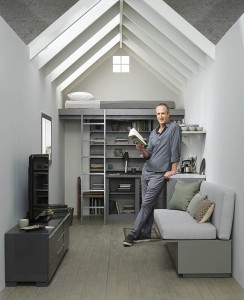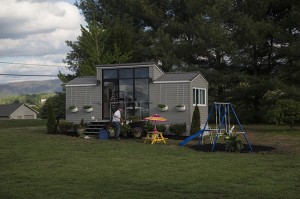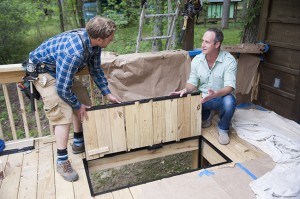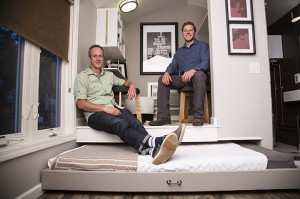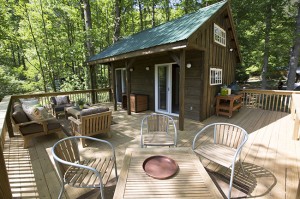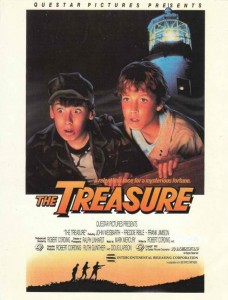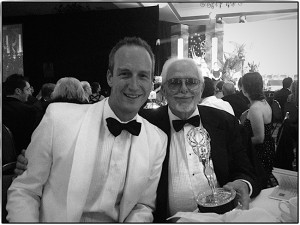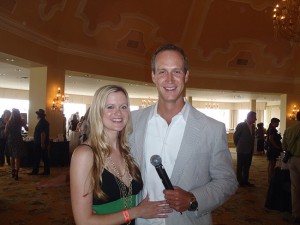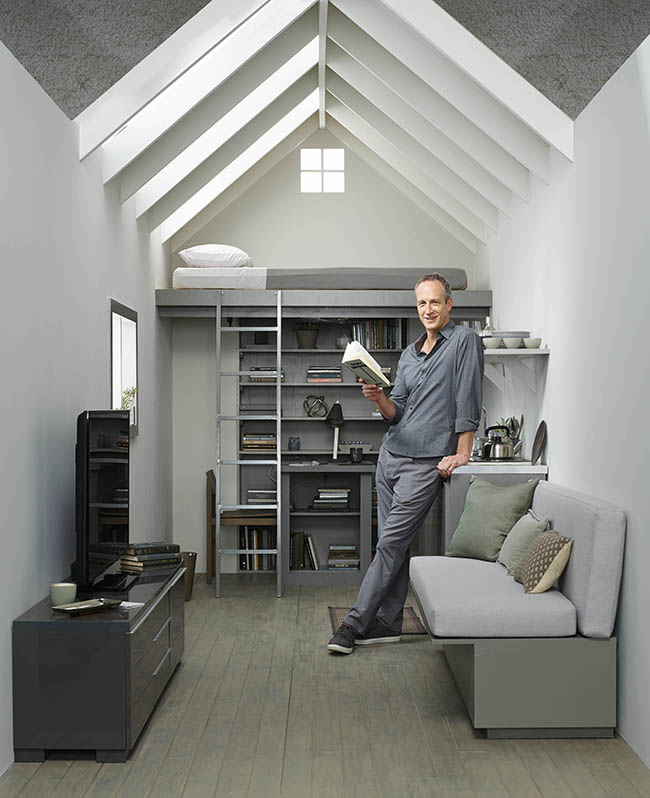John Weisbarth can hardly remember a day when he didn’t have a hammer in his hand. Back in eighth grade, young John began working with his father, Doug, at his Coronado-based “complete home maintenance” handyman business. “For the first couple of years I rode along in my dad’s truck and just handed him a wrench when he needed it,” Weisbarth said. “When I got my driver’s license, I started going out on service calls myself. That lasted all through my college years on vacations.”
Little did he know that his handyman background would indeed come in handy when a nationally televised reality show was seeking talent for a combination co-host and builder of small houses for families throughout America.
Each week on Tiny House Nation — broadcast over the new “FYI” digital cable and satellite television network that is owned by A+E Networks — Weisbarth and co-host Zack Giffin travel coast-to-coast, building homes of less than 500 square feet for couples and, in some cases, entire families.
That doesn’t leave a lot of room for espresso makers, extensive wardrobes and sets of china. Stocking up on a month’s supply of food and paper goods at Costco? Not advised.
The show, said Weisbarth, focuses on a new “sort of underground” social movement that advocates living simply in small (or tiny) houses. “The movement is driven by both environmental and economic concerns,” he said. “A smaller footprint means you’re not using as many environmental resources. And, if you aren’t spending money on rent or a mortgage every month, that presents you with a lot more time and freedom. You’ll have more income to play with; you can travel.”
To be sure, not everyone wants to live in a tiny house: the average size for a new home built in 2013 totaled 2,679 square feet, 160 more than the previous year, according to the National Association of Home Builders’ annual survey of home trends. The 2013 average house size is also bigger (by 180 square feet) than the average built during 2007’s housing peak, when it was 2,499 square feet.
According to thetinylife.com (one of many websites springing up that are dedicated to the Tiny House Movement) “most Americans spend one-third to one-half of their income on their home, which translates to 15 years of work just to pay for it. And because of that burden, 76 percent of Americans end up living paycheck-to-paycheck.”
So Weisbarth and Giffin (a professional skier who lives in a tiny house on wheels) help people realize a different kind of life: a smaller, yet richer, existence.
The renovation experts have built ingenious small spaces from pricey to budget-friendly that have included a micro-apartment in New York City, a caboose car turned home in Montana and a micro-sized mobile home for road tripping. Tiny House Nation is not a typical design show, but one that proves size doesn’t always matter — it’s creativity that counts.
The show’s producers choose the families to be featured. “In most cases, the families have written to the network and explained why they want to live in a tiny house,” Weisbarth said. “They know what they want, they’ve made the decision to radically downsize, they just don’t know how to execute it.”
Weisbarth began working on the show this spring after one episode was taped with a previous co-host, and the producers decided the chemistry didn’t work. Weisbarth explained the whirlwind of activity that ensued: “I got a call from my agent on a Thursday and he said ‘Can you do a Skype call tomorrow morning?’”
Two days later Weisbarth was on the phone with the show’s casting agent, relating his life’s work in broadcasting, plus his construction background and a web series called “Quick Fix” that he and some buddies at Cox Cable produced. It all clicked. By Monday he was on a plane to New York. He did a sample taping on Tuesday with Giffin, then flew back to San Diego on Friday. The following Monday he was off to tape his first episode in Knoxville, Tenn.
While half of the co-hosts’ job is to build and customize each tiny house, the other half is educating the family about what tiny house living entails. “We help them physically and mentally prepare for the experience of living in a very small space,” Weisbarth said, which he admitted can involve some culture shock.
In one episode, Weisbarth and Giffin built a 172-square-foot home on wheels for a couple and their toddler daughter in Tennessee. It included a full kitchen, a “princess” bedroom with play loft, and a master bedroom. A flat-screen TV, cleverly mounted above the bedroom door, could fold down and swivel for 360-degree viewing. Like many tiny houses, this family’s home is built on wheels, perfect for relocation, in this case, when the husband, a medical student, moves to a new residency position next year.
In that episode, Weisbarth and Giffin helped the couple hold a yard sale. Still, the family’s possessions needed more whittling down and Weisbarth set out just four plastic storage bins. “That’s it,” Weisbarth said firmly. “That’s all the space will accommodate.”
“There’s no question that we all have too much stuff,” Weisbarth sighed. “No wonder there are TV shows about hoarders and shows about bidding on storage rooms. But, hey, I’m not pointing the finger — I’m just as guilty as anyone else.”
One of Weisbarth’s favorite episodes featured a 500-square-foot home that he and Giffin built for a husband and wife and their two large dogs on a 37-acre parcel of land in Littleton, Colo. “In 2012, a forest fire burned their house to the ground. They went through a long mourning process. It had been their dream home and for two years they contemplated whether they should move back. Ultimately, they discovered that it was the land they loved. And we helped them build a new home. It was a very emotional episode. It was rising out of the ashes.”
Weisbarth and Giffin also built a 336-square-foot cabin on the banks of the Nolichucky River in Tennessee for a family that owned a river-rafting firm. While the home was tiny on the inside, it came with a wrap-around deck that maximized outdoor living space in the summer months.
Weisbarth’s road to Tiny House Nation was circuitous, and ultimately pulled from his endeavors in building, film, and sports.
Acting was an early pursuit set in motion by his father. “My dad was involved with the Coronado Playhouse in its early years,” Weisbarth said. “He directed some plays and built sets and that’s where he met my mom. Sometimes they needed a kid to fill a role and they’d grab me. I took acting workshops through San Diego Junior Theatre and the director, Bob Cording, was producing a low-budget movie called “The Treasure.” I auditioned and got a lead part. I had a great time filming it between seventh and eighth grades. I was 12.”
Weisbarth attended the University of California at Santa Barbara, with aspirations of playing soccer for the nationally ranked school. But the school had recruited some of the top players worldwide, and Weisbarth didn’t make the team. “It turned out to be the best thing to happen for me,” said Weisbarth, who majored in communications. “Not playing allowed me to pursue other interests like the campus radio station. My senior year I was sports director.”
Over two summer breaks back on the island, Weisbarth worked as an intern with KNSD sports director and Coronado resident Jim Laslavic. “I met Laz when he spoke at a CHS Career Day sponsored by Rotary Club, where he and my dad were [and are today] members.”
After graduating from UCSB in 1998, Weisbarth took on various freelance assignments with KNSD, U-T TV and Cox Cable (paying his dues with plenty of graveyard shifts). He landed a dream gig as co-host of the San Diego Padres pre-game show on Cox Cable TV in 2001. “I did 10 years of major league baseball in my home town and it was awesome,” Weisbarth said. “I’m a Padres fan and got to be a part of the team that brought the Padres into the new ballpark. It was really neat to meet these idols of mine growing up. I got to work with and become friends with Tim Flannery, my co-host from 2004 to 2006 — he had been my favorite player when I was a kid.”
Weisbarth has another show now airing on the national airwaves: Playing Through with John Weisbarth, a golf show that received a regional Emmy, Weisbarth’s seventh, this spring. Initially aired over the local Fox Sports channel, it has been picked up on 14 regional sports networks. “It’s hitting 60 million TV households,” said Weisbarth. “And that’s really great since it came out of thin air. A buddy and I edited and distributed it all on our own.”
Weisbarth, his wife, Megan, and their two-year-old son, Jake, now live in Talmadge, but plan to move in November into their own tiny house of sorts — a Coronado condo.
Five tips for tiny living John Weisbarth offers handy ideas for Coronado homeowners who want to make the most out of small spaces:
1 Use an open floor plan. “When you start putting in lots of rooms and cordoning them off, it begins to feel really cramped.”
2 Use vertical space effectively. “Make use of it from a storage standpoint – build shelves all the way up. Have a Murphy bed that flips up into a wall. My partner Zack and I built a Murphy bed that had a bench and cushions on the backside so the room went from master bedroom to living room. Two rooms for the price of one!”
3 Go for high lofted ceilings. “If there’s a lot of head space, the room feels more open.”
4 Everything has to be multi-functional. “That goes for every room and every piece of furniture. You can’t just have a kitchen island; it has to have storage space and maybe a big leaf to become a kitchen table. And it needs to be on wheels.”
5 Pare down — way down. “If you don’t need it, you can’t have it. Boil it down to just the essentials. Clutter is the enemy of tiny living.”
